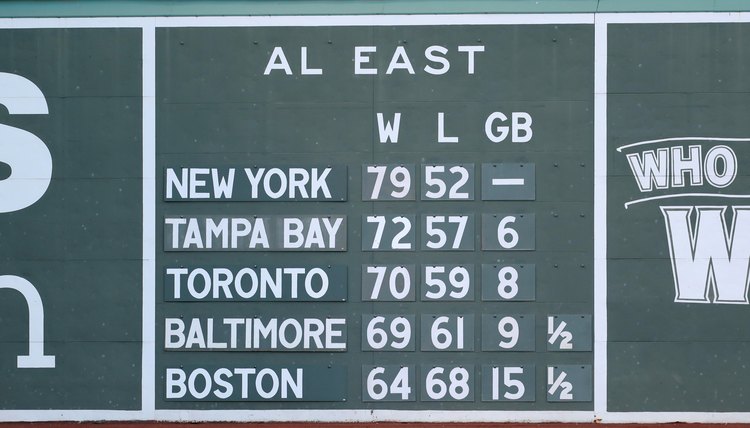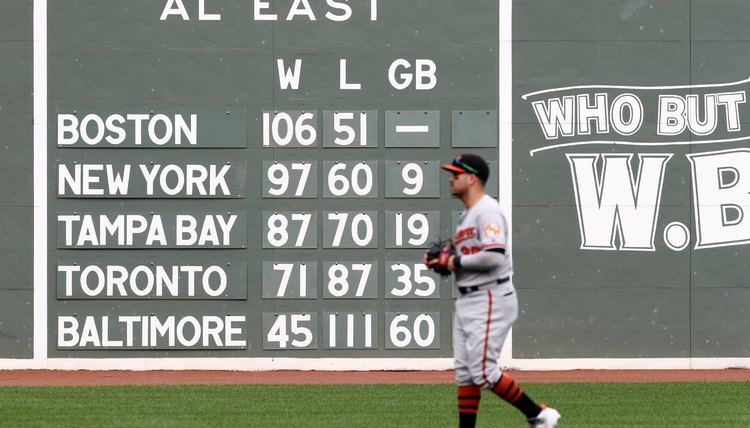Baseball Standings Explained

Throughout the MLB season, the positions of the 30 major league baseball teams are tracked through the standings. Each MLB team competes in the American League or National League in one of three divisions -- East, West or Central. In addition to its win-loss record and winning percentage, the MLB standings indicate how many regular-season games a team needs to win to secure one of the eight slots available for postseason play to compete for a World Series.
Wins and Losses
The "W" and "L" columns of the standings list the number of games each team has won and lost, respectively. For example, if the Athletics have a 20 under the “W” column and a 60 under the “L” column, they have won 20 games and lost 60 by that point in the season.

Winning Percentage (PCT)
The "PCT" column shows the teams' winning percentages, which is calculated by dividing the number of games won by the total number of games played and rounding up or down to three digits past the decimal.
For example, if the Yankees have won 60 out of 100 games at the 100-game mark, their winning percentage is .600. If the Arizona Diamondbacks have won 85 out of 162 games at the end of the season, their regular season winning percentage is .525.
Home, Road W-L Column
The "Home" and "Road" or "Away" columns show the win-loss records for each team for games played in its home stadium and as the visiting team in road games. For example if the Atlanta Braves are 20-10 at home and 10-15 on the road, it means they have won 20 games and lost 10 at home, and won 10 and lost 15 on the road.

Last 10, “L10”
The "L10" column depicts each team's win-loss record for the past 10 games, with the number of wins represented first. For example, if the Toronto Blue Jays have an L10 of 6-4, it means they have won 6 of their last 10 games, and lost four of them.
STRK
"STRK" stands for "streak," and shows each team's current win or loss streak, with "W" indicating wins and "L" indicating losses. For example, if the St. Louis Cardinals have a streak of 2L, it means they have lost their last two consecutive games. If the Seattle Mariners have a streak of 5W, it means they have won their last five consecutive games.

GB
GB in baseball standings stands for "games back" or "games behind." The top team in a division will have a dash or a zero in this slot of the standings. For each other team, GB represents the average of the difference in both wins and losses between this team and the division leader.
For example, if the division leader Houston Astros have 60 wins and 40 losses and the second-place Los Angeles Dodgers have 55 wins and 45 losses, the Dodgers are five games behind and will have "5.0" in its "GB" column.
GB is an average, so each game played only counts as a half game in regard to this number. Thus, each game won by the division leader increases the GB by 0.5, and each game won by the second-place team decreases the GB by 0.5. The GB number will increase from the top to the bottom of the division standings.
E
The elimination number, depicted as "E" or "E#," represents the combined number of wins by the division leader and losses by another team in the division needed for the top team to clinch a spot in the postseason. This number is determined by adding a team's number of wins to the number of games it still has to play in the regular season and subtracting the division leader's number of wins from the total, then adding 1.
Unlike the GB, this number will decrease from the top to the bottom of the division standings. Once this number, sometimes called the magic number, reaches "0" or "E" for the second-place team, it's no longer statistically possible for any team to beat the record of the division leader in the remaining regular-season games. An "x" or "y" may appear in the standings next to the names of the division-winning teams.

WCGB
After the six division leaders have been identified for playoff seeding, the remaining team with the best record from each league is awarded a wild card spot to bring the total number of postseason teams to eight. The race to be a wild card team often has its own standings, but it's also recorded in the "WCGB" column of the regular standings.
WCGB represents "wild card games back," and it's determined in the same way as GB, except it's calculated for all of the remaining teams in each of the AL and the NL. An elimination or magic number also applies to the wild card positions.
If two teams are tied for a playoff spot, they first look at their head-to-head record against one another as the tiebreaker.
References
Writer Bio
Andrea Reuter has a Bachelor of Arts in liberal arts from the New School. She has worked as a magazine writer and editor for such publications as "Diversion" magazine and "Original Logic Problems." Reuter currently writes articles about video games and consoles, board games and card games for various websites.
